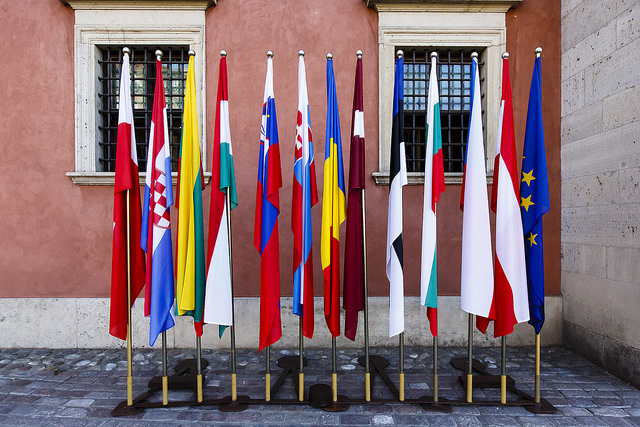Trimarium is not Intermarium
With US President Donald Trump’s visit in Poland, the brand of the Three Seas Initiative gained international reputation. In Poland where the roots of the initiative began, the Three Seas or – as one can Latinise it, Trimarium – initiative is often confused with the historical project of Intermarium, intuitively understood by many. Not only journalists but also politicians and even public officials contribute to the confusion. Well, they are wrong.
July 6, 2017 -
Dariusz Góra-Szopiński
-
Intermarium

Last August in Dubrovnik, Croatia, the heads of 12 states signed the “Three Seas Declaration”. Its aim is to strengthen the economic and infrastructural ties between the member states. The signatories represent: the four countries of the Visegrad Group (Poland, Hungary, Czech Republic and Slovakia), the three Baltic states (Estonia, Latvia and Lithuania) together with Austria, Romania, Bulgaria and two Adriatic countries: Croatia and Slovenia. All 12 countries concerned are members of the European Union.
The initiative should be regarded as a great diplomatic success of the Polish president, Andrzej Duda, and his advisor for international affairs, Krzysztof Szczerski. Prof. Szczerski is a political scientist who graduated from the same Jagiellonian University in Kraków (Duda is an alum there as well).
The outline of the Trimarium idea can be found in a book by Krzysztof Szczerski published this year under the quite adventurous title: The European Utopia: Integration Crisis and Polish Initiative of Remedy. The author describes the crisis currently touching the institutional and ideological dimensions of the EU. In a straightforward manner he develops the diagnosis and discusses possible remedies. The map of the historical Intermarium has been included into the chapter of the book where the Three Seas Initiative is presented. It shows the central belt of the European continent with the countries from Finland in the north to Greece and Albania in the south, none of them touched by Stalin’s territorial annexations of the 1940s. The borderline of the current Trimarium Initiative follows the eastern border of the European Union (around 300 km to the west comparing to the Intermarium eastern reach) and strengthens its run as stated in the set of Stalin’s agreements with Hitler from 1939-1940.
Neither Finland, Greece nor Albania expressed interested in or was invited to the current Trimarium project. What’s yet more surprising is the access of the cautious Austria. If Austria decided to take join, then the geopolitical audacity of the project has had to be as significant as something of a Liechtenstein level. Polish journalists and politicians, including the minister of national defense, while confusing the current, Liechtenstein-level project with the historical Intermarium audacity, wrongly interpret this. It was the presidential adviser Szczerski himself who stated clearly in a recent TV debate. First, the Trimarium remains a purely economic project of mutual co-operation, it has no geopolitical connotations that would associate it with the historical Intermarium. Second, the Trimarium gathers exclusively member states of the European Union, even if “there were various submissions” Szczerski affirms. One should think about Ukraine first and foremost. Its absence within the initiative is telling.
The original Intermarium idea was comprehensive and geopolitical in its nature. The current Trimarium reduces itself to the economic benefits of its very participants. As the 2016 Declaration of Dubrovnik states, the initiative is nothing but “an informal platform” within “existing mechanisms of co-operation”. The participants, as they are all members of the EU, already differ from those living eastward of the EU border. The original Intermarium idea of Józef Piłsudski was always combined with a parallel Promethean idea – the idea of liberating nations suffering from the Soviet rule. The current Trimarium project looks more self-centered. And this is the core of the problem: the risk of moral autism that would widen the gap between the eastern EU countries getting richer and richer and their “poorer relatives” deliberately kept outside the door.
One should wish for a good continuation to the newborn initiative of co-operation among the 12 EU states led by Polish President Andrzej Duda and his Croatian counterpart Kolinda Grabar-Kitarović. The most important asset is that it has effectively come to existence. Contrary to the Intermarium project of Marshal Piłsudski and his successor Józef Beck – who might have only planned their ideas without much resonance from the potential partner countries of their times. However, the Trimarium architects seem also solidary in neglecting the problems of the regions they decided not to take into account. If looking eastward through the current EU frontier one can pick out many such problems including: an unleashed raise of authoritarianism, criminalisation and oligarchisation of public life, pauperisation of population (outside the ruling elite), aggressive ethno-nationalism of dominant groups, terrorising minorities, persecuting impartial journalists and human rights activists, destructing monuments of the past, falsifying history, justifying genocide and legal protecting of war criminals, leaving an open space for the infiltration of adversarial superpowers, developing no-law zones, promoting human trafficking, drug trafficking, etc. It is easy to turn one’s eyes for not noticing the problems right outside the door. Generally speaking it cannot be called righteous. Then maybe it has to be somehow remunerative?
Dariusz Góra-Szopiński chairs the department of regional strategic studies at the Cardinal Stefan Wyszyński University of Warsaw, Poland.
This text is part of the series titled: “Intermarium in the 21st century” based on the conference held on July 6-7 2017, Lazarski University in Warsaw.

































